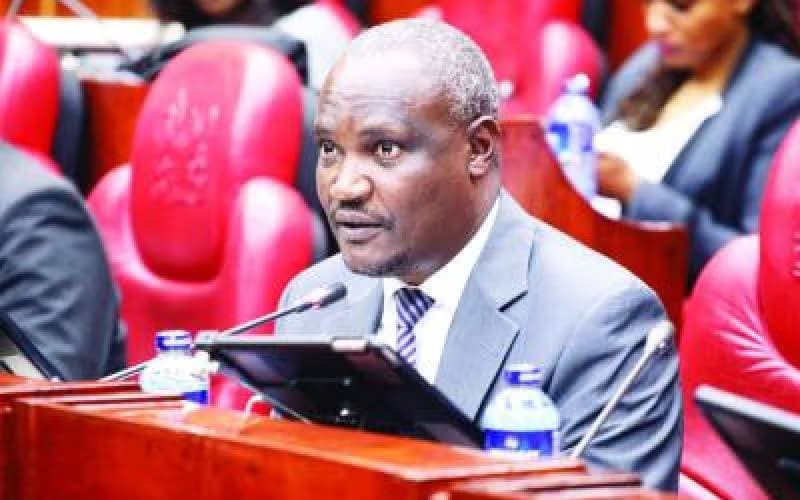Loading News Article...
We're loading the full news article for you. This includes the article content, images, author information, and related articles.
We're loading the full news article for you. This includes the article content, images, author information, and related articles.
Kenya's escalating public debt, reaching KSh 11.97 trillion by August 2025, poses significant challenges to the nation's economic stability and development priorities, with a substantial portion of national revenue now allocated to debt servicing.

Kenya's total public debt surged to KSh 11.97 trillion by the end of August 2025, marking a KSh 1.23 trillion increase year-on-year. This figure represents 67.4% of the Gross Domestic Product (GDP), according to the National Treasury's Monthly Debt Bulletin. The escalating debt is primarily driven by new domestic borrowing and disbursements from multilateral lenders. Domestic obligations constitute the larger share at KSh 6.57 trillion (54.9%), while external debt stands at KSh 5.40 trillion (45.1%).
The country's debt-to-GDP ratio has consistently remained above the International Monetary Fund's (IMF) recommended threshold of 50% for developing nations. In June 2024, this ratio was 70.0%, slightly down from 70.8% in June 2023. However, other reports indicate the debt to GDP ratio was 67.4% as of December 2024 and 67.6% in September 2024. The rapid accumulation of debt has raised significant concerns regarding its sustainability and its implications for Kenya's fiscal and macroeconomic stability.
Kenya has historically relied on public debt to finance its national development plans, supplementing tax revenue. This reliance has led to a build-up of public debt, with funds often diverted to debt servicing at the expense of economic development. In October 2023, Kenya transitioned from a nominal debt ceiling to a debt anchor set at 55% of GDP in present value terms, a move aimed at enhancing fiscal discipline and aligning with international best practices. Prior to this, the debt ceiling had been raised multiple times, reaching KSh 10 trillion in July 2022.
The Public Finance Management Act, 2012, provides the framework for Kenya's fiscal management. The government's fiscal policy for the Financial Year (FY) 2025/2026 aims to reduce the fiscal deficit from 5.7% of GDP in FY 2024/2025 to 4.8% of GDP. Total expenditure for FY 2025/2026 is projected at KSh 4.2919 trillion, with KSh 3.1344 trillion allocated to recurrent expenditures. The projected total revenue collection, including grants, is KSh 3.3218 trillion. The resulting fiscal deficit of KSh 923.2 billion for FY 2025/2026 is planned to be financed by KSh 287.7 billion in net external borrowing and KSh 635.5 billion in net domestic borrowing.
Civil society groups, such as the Institute for Social Accountability (TISA), have voiced strong concerns about the debt burden, highlighting that approximately KSh 7 out of every KSh 10 collected in revenue is allocated to debt servicing. This leaves minimal funds for essential government functions and development initiatives. Experts argue that unchecked domestic borrowing is more susceptible to misuse compared to external loans, which often face stricter scrutiny.
The high public debt levels pose several risks to the Kenyan economy. Interest payments alone are projected to reach KSh 1.09 trillion in FY 2025/2026, diverting substantial resources from productive investments. This heavy debt servicing burden can crowd out the private sector, limiting access to credit for businesses and hindering economic growth. Studies have indicated a negative effect of public debt on economic growth, with domestic borrowing instruments particularly detrimental.
Furthermore, the country's risk of debt distress remains elevated. The depreciation of the Kenyan Shilling against major currencies, especially the US dollar, exacerbates the external debt burden, as a significant portion of external debt is dollar-denominated. The rejection of the Finance Bill 2024 and the unconstitutionality ruling of the Finance Act 2023 have added uncertainty to the government's revenue mobilization strategies, further complicating debt management.
While the National Treasury provides overall debt figures, a detailed, publicly accessible list of all loans, including their specific terms, lenders, and repayment schedules, remains elusive. This lack of transparency makes it challenging for the public and oversight bodies to fully assess the country's debt exposure and the accountability of borrowed funds. There are ongoing calls from civil society for greater transparency in debt agreements.
The National Treasury is currently engaged in the budget-making process for the upcoming fiscal years, with a focus on aligning expenditures with revised fiscal frameworks and implementing expenditure cuts. The government aims to reduce the fiscal deficit to 4.5% of GDP for FY 2025/2026 and further to 2.7% by FY 2028/2029. These efforts are critical to achieving a more sustainable fiscal position and creating fiscal space for essential public services.
Key areas to monitor include the government's ability to implement planned expenditure cuts and enhance revenue collection without over-burdening citizens. The effectiveness of the new debt anchor at 55% of GDP will be crucial in guiding future borrowing decisions. Additionally, the ongoing discussions surrounding a global debt framework agreement could influence how Kenya manages its external obligations.
Keep the conversation in one place—threads here stay linked to the story and in the forums.
Other hot threads
E-sports and Gaming Community in Kenya
Active 6 months ago
Popular Recreational Activities Across Counties
Active 6 months ago
The Role of Technology in Modern Agriculture (AgriTech)
Active 6 months ago
Investing in Youth Sports Development Programs
Active 6 months ago